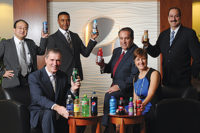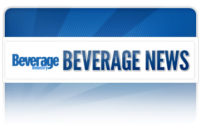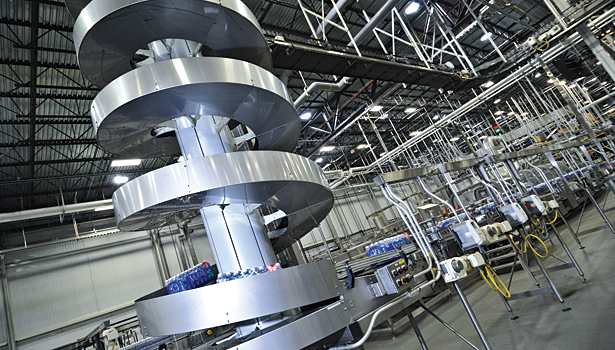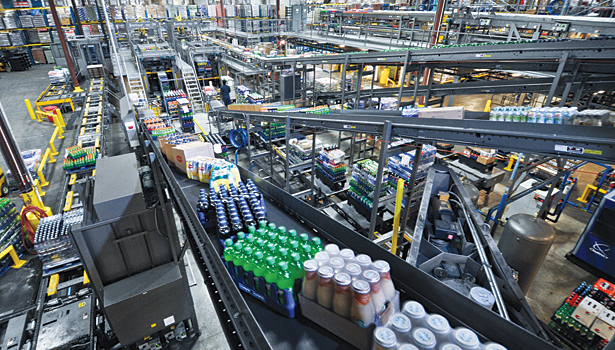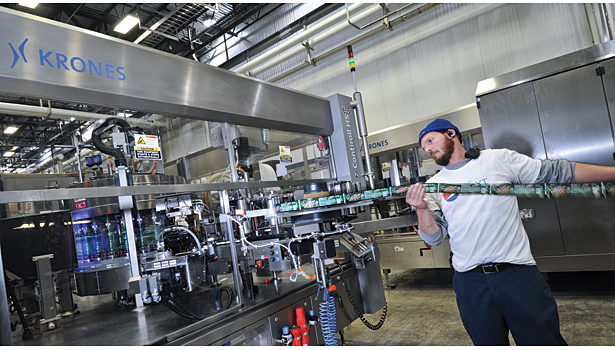Pepsi Bottling Ventures exemplifies innovation

Pepsi Bottling Ventures tea and water line operation features a centralized work station.







With six manufacturing facilities and 22 distribution operations across eight states, Raleigh, N.C.-based Pepsi Bottling Ventures (PBV) has a lot from which to take inspiration. But for the Pepsi-Cola bottler, which is a jointly owned venture between Japan-based Suntory International and PepsiCo, Purchase, N.Y., it doesn’t have to venture too far away from home to find stimulating operations.
Throughout the last decade, PBV has been developing its flagship Raleigh manufacturing and distribution facility, says Matthew Bucherati, senior vice president of supply chain and operations with PBV. Within the last four years, PBV’s owners have invested approximately $100 million in the facility to make sure it is at the forefront of innovation for the manufacturing and delivery side of the business, adds Paul Finney, president and chief executive officer of PBV.
Among those investments are bringing blow molding in-house, installation of new servo-controlled labelers, and automated processes including an automated storage and retrieval system (AS/RS) and automated case picking solutions.
“[In] the reinvention of our supply chain, we are focused on growing our footprint with automated order picking and our new mini-pallet go-to-market delivery system,” Bucherati says.
The facility also is ISO-22000 food safety qualified, which meets or exceeds all of PepsiCo’s requirements, he adds. Those upgrades have been recognized by PepsiCo as it awarded the Raleigh facility with the PepsiCo North America Caleb Bradham Platinum Award for 2011. This award is given to the production facility that maintains the highest product quality standards in the PepsiCo bottling system. It is the second time within the last three years that the Raleigh facility has received this award, Bucherati says.
“It’s a testament to say that two out of the last three years we were awarded plant of the year, and we’re very proud of that,” Finney says. “We’re very proud of Matthew [Bucherati] and his team, and it’s a testament to the work they do day-in and day-out to make sure that we get that product out there at the right time.”
Recognizing the benefits of the investments, Bucherati notes that it’s really the people who make the difference.
“All of the investments in the plant would be useless if not for the incredible team that operates it at the highest standards,” he says. “We are so fortunate to have a highly trained and dedicated group of men and women that drive our results. Leading this team is Tom Wiza, who I regard as the strongest plant manager in the Pepsi system.”
Although Bucherati and the PBV team refer to the Raleigh facility as its flagship location, those same manufacturing and distribution principles are applied throughout its 28 facilities including its Winston-Salem, N.C., operations. In 2012, PBV announced an $82 million investment in facility up-fit, machinery and equipment for the western North Carolina operations.
“In keeping with the complete reinvention of our supply chain, we’ve acquired a new half-million-square-foot facility located very close to the Winston-Salem manufacturing plant,” Bucherati says. “We’re developing it in the balance of [2012] and into 2013 as our second automated order picking distribution center where we’ll be serving the entire western half of our North Carolina franchise. Over the next several years, we will evolve this facility into a new modern manufacturing site focused on producing the new innovation and emerging products that are growing in the marketplace.”
Currently operational in a distribution capacity, the upgrades will automate the facility and add manufacturing dynamics.
“We envision continuing to add new manufacturing platforms not traditionally found in [carbonated soft drink] (CSD) facilities including aseptic manufacturing and pasteurization processes,” Bucherati says.
The upgraded facility will allow PBV to retain more than 300 current jobs and consolidate additional jobs within one facility.
Noting the importance of streamlining the supply chain, Bucherati notes that PBV operates with a purpose-driven goal. “Our mission and goal is to always have the lowest cost and highest quality products in every area of our business,” he says.
Efficiency throughout
With approximately 750 SKUs — 575 in the Carolinas — and 2,400 employees throughout the company’s facilities in its North Carolina, New York, Maryland, Delaware, Vermont, Idaho and South Carolina territories to serve its more than 9 million consumers, PBV understands the importance of efficient practices and the challenges that can accompany such a broad base.
As part of its advanced label orientation system at the Raleigh facility, the servo-controlled equipment ensures that the graphics on the label match perfectly with the facing on the bottle, Bucherati explains. For example, all Mountain Dew sidekick bottles, which PBV has been carrying for approximately two years, are sent out to the retailers with perfectly aligned brand images for both the label and the brand logo located on the bottle, he adds. Any product that is not aligned is kicked out of the production line, he says.
For its direct blow-fill water and tea line, PBV features an equipment-centralized work station with one operator monitoring the processes and servicing the machines. Because of the centralization of the equipment and color-coded visual cues located in elevated placements, the operator is able to monitor the processes for overall equipment effectiveness, explains Tom Wiza, plant manager for PBV’s Raleigh facility.
PBV also applies those same efficient practices to resources. At its Raleigh location, light intensifying skylights were installed to harness the natural light. The facility also features high-efficiency lights that adjust their brightness based on the amount of light outside, Bucherati says.
The company also installed a system for water recycling, and its Nampa, Idaho, facility was recognized as a “Pollution Prevention Champion” by the Idaho Department of Environmental Quality (DEQ) for its successful efforts to reduce pollution in 2012. Additionally, the company is dedicated to reducing the amount of waste that is being sent to the landfill. Currently, nearly 80 percent of the waste generated from its bottling operations is recycled, including aluminum, plastic, cardboard and scrap metal, the company says. At the Nampa facility, PBV also installed energy-efficient industrial lighting systems that save more than 700,000 kilowatts annually. In addition, various process changes allowed PBV to reduce its overall wastewater generation by 35 percent in 2012 and helped to cut down on overall water use by 14 percent during the same period, the company reports.
Highlighting its commitment to fuel efficiency, PBV has purchased both small hybrid vehicles and hybrid tractor trailers.
“[PBV has a] large commitment to sustainability; we acquired over 200 small hybrid vehicles, and we have a number of hybrid tractor-trailer delivery vehicles as well and an aggressive focus on fuel economy,” Bucherati says.
With more than 3,300 fleet assets, PBV is in the process of a redesign of its delivery fleet by shifting away from traditional side-loaded route trucks to more efficient large box truck delivery systems that feature mini pallets that are assembled based on individual deliveries for its small-format customers, he adds.
These custom-built pallets are supported by PBV’s automation capabilities such as its AS/RS operation and automated case picking system.
With SKU proliferation continuing throughout the beverage industry, storage and order fulfillment must also keep up with the rest of PBV’s efficiency practices. Allowing for denser storage of its 575 SKUs, PBV installed an AS/RS. The installation was divided into two phases with the initial phase beginning in fall 2011 and completion of the final phase in June 2012. The AS/RS system feeds the automated case picking system by feeding product through a series of conveyors that are then fed to robot palletizers for the assembly of custom-built pallets based on the customer’s order, Bucherati explains.
The automated case picking system allows PBV to reduce the number of fingerprints associated with each pallet to help reduce possible error and also allow for orders of mini-pallets for its side-bay fleets. These mini-pallets offer significant productivity and distribution improvements, Bucherati explains, because they allow for quick delivery, can be rolled right through the door, and take up less space on the store floor.
Customer focus
With more than 25,000 customers, PBV’s day-to-day operations are designed to anticipate customer needs and support timely fulfillment operations.
“We have specific software tools that let us focus on predictive forecasting and production scheduling three weeks out, but our day-to-day operations are meant to support a 24-hour sales cycle,” Bucherati says.
Using advanced routing software that is fed into its automated order picking system, the sales staff uses handheld technology to send customer orders.
“Our production is centered around demand-based, predictive forecasting,” Bucherati says. “We focus on production scheduling, [which] really [is] a balance between low-cost production scheduling and economic lot sizes while still meeting the demands of sales with the goal of [keeping] more than 99 percent of all products [in stock] … or a 99 percent fulfillment rate.”
With such a variety of customers, PBV makes sure it is meeting the different needs of all of its clients.
“We have vending machines [customers] that will do at least two cases per vending machine per week all the way up to large format accounts that do over 325,000 cases a year,” Finney says. “You can imagine [that] if you’re a sales rep calling on an account that does over 325,000 cases a year, you’re basically sending in close to 1,000 cases a day of product to keep it in stock, so we have to have a system that flexes all the way from the vending machine that does the two cases per week to the large format account that does over 325,000 cases a year.”
Perhaps just as challenging as meeting the variety of needs for its customers is the demographic complexities associated with having operations in eight states.
“Our consumers are different between the South, Vermont and Idaho, and ensuring that we have the right packages and marketing programs for those consumers is obviously a challenge for us,” Finney says. “It’s also a strength for us, though, because it allows us to fully leverage the different opportunities that each of those places present and ensures that we’re competitive across the board, so it’s a blessing as well as a challenge for us to do business across eight states.”
Although PBV works with the customer in mind, the bottler also is in constant communication with PepsiCo to ensure that its facilities meet and sometimes even exceed the company’s standards.
“I think one of the things that’s a testament to Matthew [Bucherati] and his group is that when Pepsi brings out these new programs, they come to Matthew [Bucherati] first and test it out through him and his team to make sure that it’s something that’s going to be applicable to the system,” Finney notes. BI
Looking for a reprint of this article?
From high-res PDFs to custom plaques, order your copy today!




